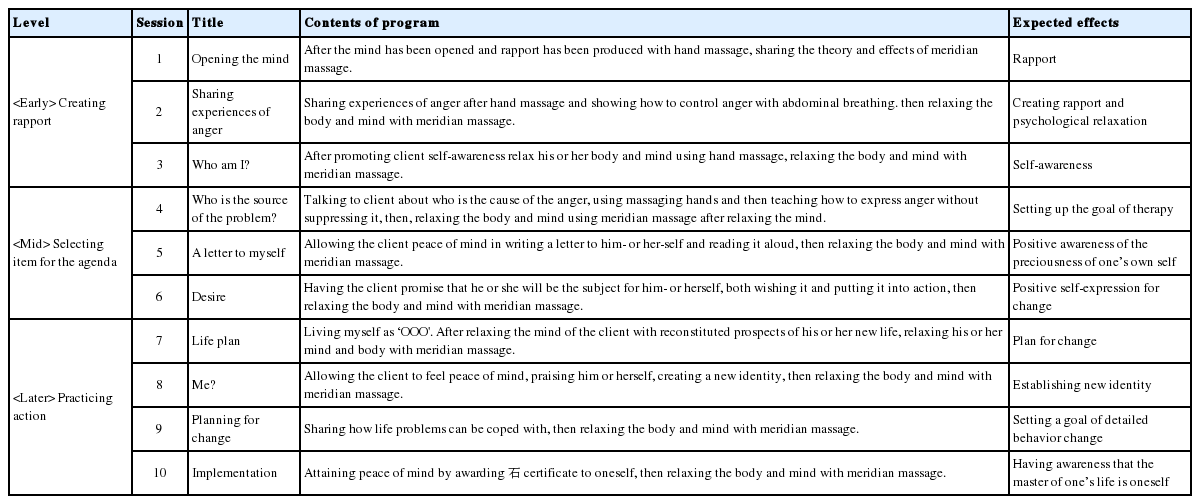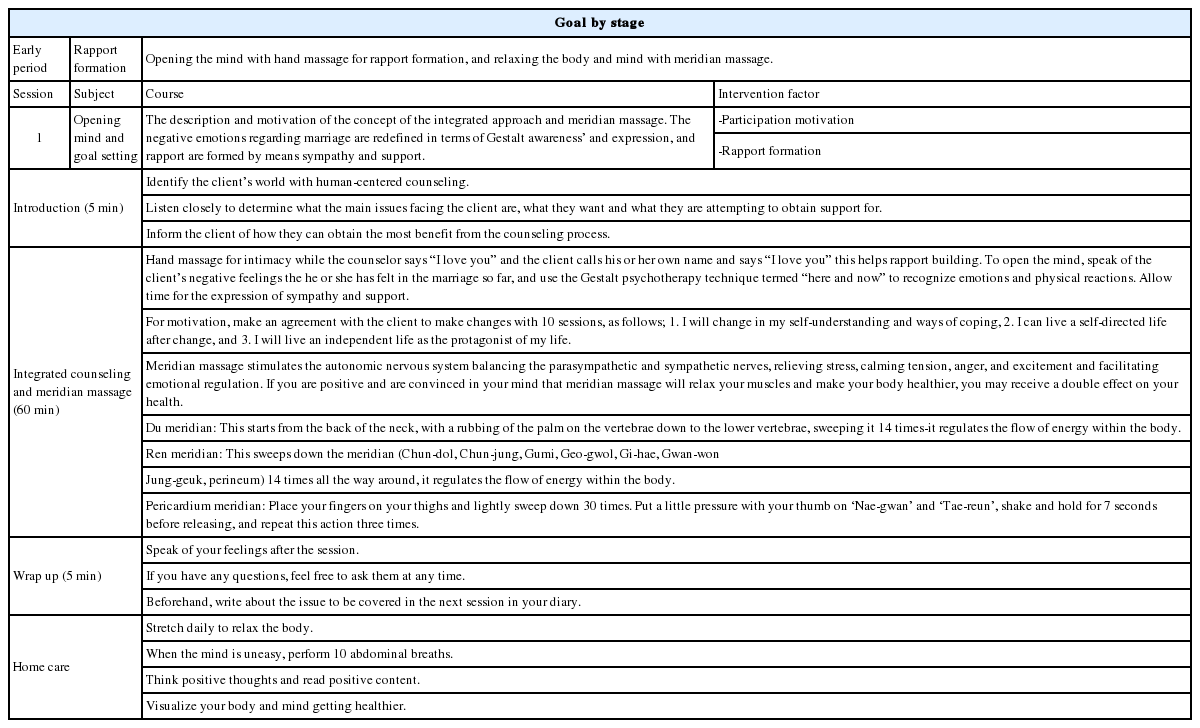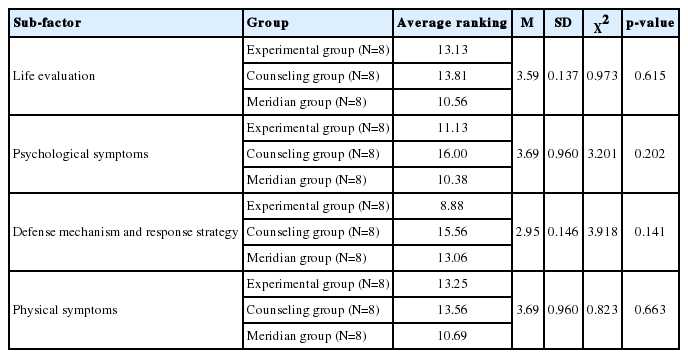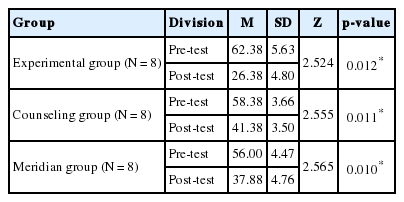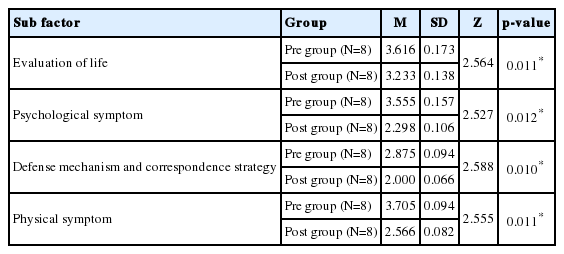미용심리치료 프로그램이 중년여성의 화병 완화에 미치는 효과
Effects of a Cosmetic Psychotherapy Program using an Integrated Approach with Counseling and Meridian Massage on Hwa-byung Relief for Middle-aged Women
美容心理治疗计划对缓解中年女性心火病的效果
Article information
Abstract
목적
본 연구는 중년여성의 화병을 감소시켜 삶의 만족감과 행복감 증진에 도움을 줄 수 있는 미용심리치료 프로그램의 효과를 검증하는데 목적이 있다.
방법
연구 대상은 D지역에 거주하는 45–65세의 여성으로 참여 의사에 따라 동질성 검사 후 실험집단 및 두 개의 비교집단에 각각 8명의 여성을 배정하였다. 이들을 대상으로 주 1회, 매회기 70 min, 총 10회를 실시하였다. 본 연구의 효과는 비모수적 방법인 Kruskal-Wallis를 통해 검증하였고, 각 회기별로 행동변화를 관찰하였으며, 3개의 집단에 대한 효과 분석을 위해, 일원배치분산분석(analysis of variance, ANOVA)을 실시하였다.
결과
첫째, 미용심리치료 실시 후 중년여성의 화병 완화 효과가 유의미한 차이를 보였다.둘째, 회기별 변화를 볼 때 심리적 증상이 실험 전보다 실험 후 긍정적인 방향으로 변화되었으며 방어 기재 및 대응전략의 경우 미래에 대한 긍정적인 생각이 증가하였다.
결론
본 연구를 통해 미용심리치료 프로그램이 중년여성의 화병 완화에 효과적임을 알 수 있었다.
Trans Abstract
Purpose
The purpose of this study was to develop and apply the beauty psychotherapy program which can reduce the Hwa-byung among the middle-aged women and help to improve their satisfaction and happiness in life.
Methods
The subjects of this study are the middle-aged women between 45 and 65 years of age. They underwent experimentation, and meridian counseling, in groups of eight people each, after taking the homogeneity test in accordance with the participation intention. The study was conducted by way of one session a week for 10 weeks. Each session lasting 70 min. This study uses the Kruskal-Wallis test, a nonparametric method, to observe behavioral changes during each session. After conducting experiments among three groups, the statistical data were analyzed using the analysis of variance (ANOVA) method.
Results
First, beauty psychotherapy program was efficient in relieving the Hwa-byung among the middle-aged women. Second, according to the changes in each session, the psychological symptoms showed a positive change after the experiment was conducted, compared with those before the experiment. The defense mechanism and correspondence strategy, showed increase in positive ideas about the future.
Conclusion
In this study, it was found that the beauty psychotherapy program is effective in mitigating the Hwa-byung among the middle-aged women.
Trans Abstract
目的
本研究的目的是通过缓解中年女性的心火病,为提高中年生活满足感和幸福感,开发和应用美容心理治疗计划, 并分析其效果。
方法
研究的对象是以D区域居住的45岁到65岁以下的女性,按照参与意向进行同质性检查后,分为实验 组、咨询组、经络按摩组,每组各安排8名。每周1回,每回70分,总实施10回。本研究实行非参数方法 Kruskal-Wallis 验证,每回进行实验后,观察其行为改变。为确认实验后效果的差异分析,并对其结果进行单向配置分散分析(analysis of variance, ANOVA)。
结果
第一,美容心理治疗计划实施后,缓解中年女性心火病的效果方面具有统计意义的差别。第 二,从每一次的变化来看,与实验前比较,实验后的心理症状变为正向发展,而且防御机制和对应战略方面呈现了对未 来肯定的思想变化。
结论
从以上研究中得出,美容心理治疗计划对缓解中年女性的心火病方面具有效果。
Introduction
전통적으로 한국 여성은 개인보다는 가족 중심의 생활을 하였다. 지금의 중년기 여성들은 남편에 대한 내조와 자녀 양육에 큰 역할을 담당하였는데 그에 비해 자신의 자아실현이나 건강에 대해서는 소홀히 여겨왔다(Park & Chae, 2001). 자기 자신을 돌볼 시간적 여유 없이 중년의 나이가 되어 정신적, 육체적으로 쇠약해진 자신을 돌아보며 지금까지의 삶을 뒤늦게 후회하게 되는 경우가 많다. 사회에 대한 자신감 부족과 자신에 대한 자존감 저하로 새로운 삶을 도전하기가 쉽지 않고, 내가 지금 할 수 있는 것이 없다는 자기 자신에게 먼저 화가 나게 되는 경우가 많다. 자기 자신에 대한 이러한 상실감과 주변 사람들에 대한 서운함을 가족에게 표현하지 못하고 꾹꾹 억눌러 참고 지내다 보면 화병(火寎)으로 이어지는 경우가 빈번히 발생하기도 한다. 이는 한국인의 본성에서 그 요인을 찾을 수 있는데, ‘자식에 대한 헌신적인 사랑’과 ‘참는 것이 미덕’이라는 우리의 전통적인 문화와 깊은 관련이 있다(Jo & Hwang, 2013).
또한 1995년 미국정신의학회에서 발간한 ‘정신장애의 진단 및 통계 편람 4판’ (Diagnostic and statistical manual of mental disorders, DSM-IV)에서는 화병을 한국의 사회문화적 배경을 바탕으로 생겨난 문화 관련 증후군(culture-bound syndrome)이라고 언급하고 있다(Kim et al., 2013). 결국 화병은 우리민족의 사회, 문화와 관련된 질병이라 할 수 있다.
화병이란 민간에서 화(火)의 역동성을 상징으로 사용하여 온 병명으로, 울화병이라고도 한다(Chi et al ., 1997). 화병의 신체적 증상으로는 불면증, 피로감, 우울감, 소화불량, 식욕감퇴, 두통, 호흡곤란, 가슴 답답함, 속에서 뭔가 올라오는 느낌, 또는 순간적으로 화가 난다거나 가슴에 덩어리가 있다는 느낌 등이다. 화병은 장기간 누적된 상태에서 억울한 감정이 폭발하여 생기는 질환이며, 주로 마음이 원인으로 작용하여 발생되는 심신병으로 한국에서 흔히 볼 수 있는 일종의 분노증후군이다(Park & Lyu, 1997). 고통스러운 결혼생활, 가난과 고생, 사회적 좌절 그리고 개인의 성격에 의한 속상함, 억울함, 분함, 화남, 증오 등이 그 주된 원인이다(Shin & Lee, 1998). 일반적으로는 화병을 심각하게 인식하지 않고 단순히 스트레스로 여겨 자신의 예민한 성격 탓으로 참고 넘기려 하는 경우가 많다. 따라서 적절한 화병 완화 및 치료 방법에 대한 연구의 필요성이 높아지고 있다.
본 연구자는 효과적인 화병 완화 방법으로 미용심리치료 프로그램을 제시하였다. 미용치료는 중년여성이 건강한 노후를 맞이하는데 도움이 되기 위해 정신역학과 심신관계에 개입함으로써 개인들의 삶에 심층적으로 다가서 치료하고자 하는 방법이며, 특히 미용치료의 한 분야인 경락마사지는 정신적·신체적 이완과 자율신경계 조절을 통해 질병의 예방 및 치료뿐만 아니라 스트레스, 긴장, 분노, 우울, 일상생활의 활력 순으로 치료에 뚜렷한 효과를 입증하고 있다(Yun & Shin, 2012). 또한 미용치료에서 경락마사지를 하기 전에 통합적 접근 기법의 상담을 실시하여 효과를 극대화시킬 수 있다. 통합적 상담 이론은 인간상담 이론, 인지·행동주의 이론, 게슈탈트(Gestalt) 이론 등을 통합하여 내담자의 사고, 감정, 행동에 종합적으로 관심을 두고 심리치료를 하는 관점이다(Lee, 2013). 현재까지 미용으로 스트레스, 우울증 등을 치료한 사례는 많이 있었으나 미용을 화병에 적용한 논문은 미비한 실정이기에 통합적 상담 이론에 근거한 미용심리치료 프로그램을 실시하여 중년여성의 화병 완화에 대한 긍정적 측면을 살펴보고 미용치료의 학문적 기초자료로 제공하고자 한다.
Methods
1. 연구대상 및 자료수집
본 연구는 D지역에 거주하는 화병을 가지고 있는 중년여성(45–65세) 100명 중에서 질병이나 정신질환의 기왕력이 없으며 이와 관련된 약물을 복용한 적이 없는 사람들에게 화병 척도 검사 설문을 실시하여 총 120점 이상이 나오고, 맥파계 측정 결과 누적 스트레스가 45이상으로 집단 간 동질성 검증에 적합한 자로 선정하였다. 실험집단(통합적 접근 상담과 경락마사지 8명), 비교집단(통합 접근 상담 8명, 경락마사지 8명)으로 구성하여 총24명의 연구대상을 확정하였다.
2. 사전 동질성 검사
본 연구대상인 화병을 가진 중년여성 집단은 실험집단과 비교집단인 상담집단과 경락집단 3개의 집단으로 나누어 비모수적 방법인 Kruskal-Wallis 검정으로 사전집단별 동질성, 스트레스집단 간 동질성을 검증하였다.
3. 연구방법
1) 미용심리치료 프로그램 진행
중년여성의 화병 완화를 위하여 통합적 접근 상담을 근거로 하여 경락마사지를 이용한 미용심리치료 프로그램을 수행하였다. 프로그램은 본 연구자의 의견과, 미용관리사, 상담전문가의 평가를 종합하여 과거의 삶을 긍정적으로 재구성하고 방어 대응전략으로 화에 대응할 수 있도록 구성하였고, 내용은 초기, 중기, 후기 단계로 구분하였다(Table 1).
미용심리치료 프로그램은 1–10회기까지 주1회, 1회기 당 시간은 70 min 동안 진행하였다. 프로그램의 구체적 세부내용은 친밀감 형성, 억압된 감정을 중심으로 통합적 접근 상담을 진행한 이후 경락마사지로 몸과 마음이 이완되도록 하였으며, 효과성을 높이기 위해 회기마다 동일하게 적용하였다(Table 2).
2) 화병 척도 측정
본 연구에서는 화병 및 스트레스 척도, 신체적 증상 및 대응전략을 측정하였으며 설문지를 돌려 각 체크 문항 50을 5점 리커트 척도로, ‘전혀 그렇지 않다’ 1점, ‘그렇지 않은 편이다’ 2점, ‘보통이다’ 3점, ‘그렇다’ 4점, ‘매우 그렇다’ 5점으로 구성하였으며 본 연구에서의 신뢰도는 Cronbach’s α=0.93이었다.
3) 맥파에 의한 스트레스 측정
맥파에 의한 스트레스는 uBioClip (Biosense Creative, Korea)를 이용하여 측정 및 분석하였다. 스트레스지수 해석을 보면 25이하는 스트레스가 거의 없는 상태이고, 25이상 35이하는 일시적인 스트레스 상태, 35이상 45이하는 초기 스트레스 상태이며, 45이상 60이하는 일시적인 스트레스가 반복적으로 쌓이며 스트레스 내성이 약해지기 시작하는 시기로 본다. 60이상은 만성스트레스로 진행되기 전 상태로 매우 위험한 지수다.
4) 자료 분석
본 연구는 수집된 모든 자료는 각 검사의 채점기준에 근거하여 점수화한 후에 Statistical Package for the Social Sciences (SPSSWIN 12.0; IBM, Korea) 프로그램을 이용하여 세 집단의 통계적 분석을 진행하였으며, 비모수적 방법인 Kruskal-Wallis 검정을 실시하여 사전집단 간 동질성분석을 진행하였다. 또한 실험집단과 비교집단의 사전·사후 분석은 비모수적 방법인 Wilcoxon 부호 순위 검정을 실시하였다. 실험집단과 비교집단의 사후 효과 분석은 세 집단의 실험 후 효과 차이분석을 위해, 일원배치분산분석(analysis of variance, ANOVA)을 실시하였으며, 각 집단별 사후 검정을 위하여 Bonferroni 검정을 실시하였다.
5) 회기별 분석
본 연구에서는 프로그램의 결과 분석에서 통계적 검증에 따른 양적 결과의 신뢰성이 갖는 한계점을 보완하기 위하여, 매 회기별 인터뷰를 통해 이해하고 기술한 내용을 분석하여 회기별 집단의 심적 변화 양상에 대한 현상학적 분석을 실시하였다. 이렇게 분석한 내용을 힘든 감정의 재구조화 과정에 따라 배열하여 개인별 변천기제를 설명하였다. 놓치기 쉬운 내담자의 행동 관찰, 심리 분석, 일상생활 분석 등 내담자의 치유 및 변화 과정에서 나타난 현상을 주관적인 경험을 통해 그 속성을 분석하여 본 연구의 효과성을 검증하였다.
Results and Discussion
1. 중년여성의 화병 특성
중년여성은 노년기를 눈앞에 두고 있는 상황에서 남편의 외부 활동으로 집안의 경조사나 노년기 부모를 수발해야 하는 부담을 지게 된다. 또한 신체적으로는 폐경과 함께 갱년기 증상을 겪으며, 이와 함께 사회적으로 요구되는 여성성에 대한 상실을 경험한다. 그럼으로써, 중년여성은 이제까지 살아온 그들의 삶을 재평가하고, 자신의 상황에 적합하게 자아상, 생활양식, 가치, 태도를 변화시키려는 시도를 하게 된다.
심리학에서는 화병이 심리적 스트레스를 겪고 갈등과 체념의 기간을 거치면서 발병하게 되었다고 한다(Kim et al ., 1997). 또한 화병의 원인은 우리나라의 억압 문화와 관련되어 강한 심리적 스트레스를 억제하는 데에서 기인한다고 설명하였고(Min, 1989), 모든 것이 억울함과 분함이 주된 원인이며, 개인의 인지적 틀과 스트레스를 지각하는 정도에 따라 더욱 영향을 받는다고 설명하고 있다(Lim et al ., 2000). 화병의 발생 기제는 내부에 침전된 분노나 원한의 강도가 점점 심해져서 스스로의 힘으로 통제할 수 없을 경우 화가 깊어지면서 화병으로 발전된다고 한다. “당신의 화병은 직접적인 원인이 무엇이라고 생각하십니까?”라고 물으면, “제 성격에도 문제가 있습니다.”라는 공감을 표시한다. 화병에 잘 걸리는 성격으로는 고지식하고 양심적이며, 항상 감정을 억제하고 뭐든지 “내 탓이오.”라고 인내하는 사람들이라고 할 수 있다. 화병을 주전자라고 비유하면, 뚜껑이 닫혀 있는 주전자에 스트레스를 계속 가할 때 나타나는 반응이 화병입니다. 뚜껑이 열려 있으면 분출되고 하지만 주전자가 낡았다면 열을 견디지 못하고 터지게 된다. 이렇게 울화된 억울한 감정을 제대로 발산하지 못하고 억지로 참는 가운데 생기는 것이 화병이다(Kwon & Choi, 1999).
한은 목, 가슴 증상으로는 가슴속 덩어리, 응어리, 답답함, 한숨, 치밀어 오름, 통증으로는 두통을 위시하여, 관절통, 요통, 열감으로는 몸과 얼굴이 화끈 달아오름, 더운 느낌, 더위 못 참음 증상들을 ‘화복합(hwa complex)’ 이라고 하였다(Min, 2009).
대부분 일이 힘들거나 커다란 충격을 받았을 때, 가슴이 답답하고, 숨이 차고, 기운이 없으며 소화가 잘 안 되고 명치에서 목을 향해 열이 오른다고 한다. 한국 사람들이 흔히 “울화가 치민다.”라고 표현을 많이 하는데, 오랫동안 참았던 울화, 분노 등이 쌓여 있다가 나이가 들고 정신적 육체적으로 기능이 저하되어 더 이상 참기 어려울 정도로 건강치 못할 때 폭발하면서 다양한 증상으로 나타난다.
2. 사전집단 간 동질성 분석
사전집단별 및 스트레스집단 간 동질성 분석을 위하여, 비모수적 방법인 Kruskal-Wallis 검정을 실시하였다. 사전집단별 동질성 분석 결과, 삶의 평가(χ2=0.973; p =0.615)는 사전집단 간 동질한 것으로 나타났으며(p >0.05), 심리적 증상(χ2=3.201; p =0.202) 또한 사전집단 간 동질한 것으로 나타났다. 방어기재 및 대응전략(χ2=3.918; p =0.141), 신체적 증상(χ2=0.823; p =0.663)으로 전 하위 요인들의 사전집단은 동질한 것으로 나타났다(Table 3). 스트레스집단 간 동질성 분석 결과, 맥파계를 활용한 스트레스 지수의 사전집단 간 동질한 것으로 나타났다(χ2=5.416; p =0.067) (Table 4).
실험집단과 비교집단의 사전·사후 스트레스 차이를 맥파계로 측정한 결과는 Table 5와 같다. 실험집단의 스트레스 지수는 유의수준(p <0.05)에서 통계적으로 사전집단과 사후집단의 차이가 있는 것으로 나타났다(Z=2.524; p =0.012). 실험집단의 경우 사전보다 사후에 스트레스 지수가 낮아지는 것으로 나타났으며, 상담집단의 경우 유의수준(p <0.05)에서 통계적으로 스트레스 지수가 사전집단과 사후집단의 차이가 있는 것으로 나타났다(Z=2.555; p =0.011). 상담집단의 경우도 상대적으로 사전보다 사후에 스트레스 지수가 낮아지는 것으로 나타났다. 또한, 경락집단도 유의수준(p <0.05)에서 통계적으로 스트레스 지수가 사전집단과 사후집단의 차이가 있는 것으로 나타났다(Z=2.565; p =0.010). 경락집단의 경우도 상대적으로 사전보다 사후에 스트레스 지수가 낮아지는 것으로 나타났다.
실험집단과 상담집단, 경락집단의 실험 후 효과에 대한 차이 분석을 위해, ANOVA를 실시하였으며, 각 집단별 사후 검정을 위하여 Bonferroni 검정을 실시하였다. 집단별 스트레스 지수는 유의수준(p <0.05)에서 통계적으로 집단 간 차이가 있는 것으로 나타났다(F =25.44; p =0.000). 사후 검정 결과, 실험집단과 상담집단, 경락집단에서 차이가 있는 것으로 나타났으며, 실험집단이 스트레스 지수가 가장 낮았으며, 경락집단, 상담집단 순으로 나타났다(Table 6).
3. 중년여성의 화병 완화의 초기, 중기, 후기 단계별 분석
1) 내담자 A 초기단계
초기단계는 1회기에서 3회기까지이며 내담자의 마음의 문을 열기 위한 단계이다. 상담자가 손 마사지를 시작하면서 “사랑합니다.”라고 하는 말에 내담자는 깜짝 놀라는 것 같았으며, 내담자 스스로에게 “oo야! 사랑한다.”라는 것을 해보라고 했을 때 내담자는 작은 목소리로 말을 하면서 쑥스러워 하였다. 이와 같은 방식으로 상담자는 내담자에게 심리적으로 접근하면서 인간중심상담을 통해 내담자의 세계를 파악하기 위해 결혼생활에서 느껴왔던 부정적인 감정을 마음껏 이야기하는 시간을 가졌다. 가족 중 남편의 이야기를 시작하면서 표정이 어둡고 눈에 눈물이 고여 있었으며, 억양이 높기도 하고 낮은 목소리 떨림도 있었으며, 중간 중간 물을 자주 마시며 10 min간 이야기하는 것으로 보아 남편에게 화(불만)가 쌓였다는 것을 해석할 수 있었다. 초기단계에 나타난 이런 행동을 통해 자신보다는 가족을 먼저 생각하고 살았는데 지금은 아무도 알아주지 않아서 섭섭하고 억울하고, 화가 많은 삶을 살아 왔다는 것을 분석할 수 있었다(Table 7).
2) 내담자 A 중기단계
중기단계는 4회기에서 6회기까지이며 내담자 자신의 마음속에 내재된 의제화를 표현하여 심리적 정화와 개선을 경험하는 단계이다. 영상을 보고, 자신에게 칭찬의 글을 낭독하고 ‘누가 문제인가?’ 또 ‘나는 어떤 성격의 소유자인가?’라는 질문에 대답해 보도록 하였다. 내담자는 ‘거울’이라는 칭찬의 글을 낭독하지 못하고 한참 동안 글을 보면서 눈에 눈물이 고여 있다가 마침내 떨리는 목소리로 낭독을 하였다. 가족의 이야기를 하면서 남편이 문제라고 생각을 했는데 문제는 자기 안에도 있다고 하였다. 자신이 감정표현을 잘 하지 못하고 참고만 있다 보니 이런 현상이 생겼다고 하였다(Table 8).
3) 내담자 A 후기단계
후기단계는 7회기에서 10회기까지이며 내담자의 행동 취하기로 긍정적 자기인식과 타인인식으로 변화계획을 실천하는 단계이다. 새로운 변화의 삶의 실천 방안을 구상해 보면서 매 회기마다 일기를 쓰고 긍정의 말을 낭독한 것이 도움이 되었다고 하였다. 노래교실에 결석하지 않고 가고 있으며, 남편과 이야기하는 시간이 늘어나고 있다는 것은 긍정적인 이미지로 보였다(Table 9).
Conclusion
본 연구에서는 미용심리치료 프로그램이 중년여성의 화병 완화에 미치는 효과를 분석하고자 하였다. 프로그램 개발모형의 문헌연구를 고찰한 후 이를 토대로 문제점 및 제한점을 보완하여 10단계로 구성된 미용심리치료 프로그램 개발 모형에 맞추어 이루어졌다. 프로그램 내용 절차는 미용관리사, 상담전문가에게 프로그램의 목적과 내용에 대한 타당도를 근거로 수정 및 보완되었으며 예비 프로그램을 실시하여 효율성을 평가하고 내담자의 피드백을 통해 수정 및 보완 절차를 거쳐서 최종 본 프로그램으로 개발하였다.
첫째, 미용심리치료 프로그램의 화병 완화 효과와 관련하여 비교집단인 통합적 접근 상담, 미용경락집단 간에 사전보다는 사후의 편차가 증가했으나, 미용경락과 상담을 동시에 실시한 실험집단에서 사전과 사후 사이의 유의수준(p <0.05)에서 차이가 큰 것으로 나타났다.
둘째, 회기별 변화를 볼 때, 심리적 증상이 실험 전 보다 실험 후 긍정적인 방향으로 변화되었으며, 방어기재 및 대응전략의 경우 ‘삶에 대한 평가’에 있어서는 비교집단인 미용경락집단과 통합적 접근 상담 집단간에 차이가 유의미하지 않았으나 실험집단에서는 사전과 사후 사이의 유의한 차이가 있었다. 실험집단과 미용경락집단의 화병 하위요인을 살펴보면 삶의 평가, 심리적 증상, 방어기제 및 대응전략이 사전과 사후 사이의 유의 하다고 분석되었으며, 신체적 증상은 차이가 없는 것으로 나타났다. 실험집단과 상담집단의 화병 하위요인을 살펴보면 삶의 평가, 방어기재 및 대응전략에서 유의한 차이는 없으나, 심리적 증상과 신체적 증상은 사전과 사후 사이의 유의한 차이가 있다고 나타났다. 미용경락집단과 통합적 상담집단의 화병 하위요인을 살펴보면 삶의 평가, 심리적 증상, 방어기제 및 대응전략, 신체적 증상 모두 유의 하다고 분석되었으며 신체적 증상에서는 경락집단이 좀 더 유의 확률이 높다는 분석이 나왔다(Table 10).
본 연구에서는 소수의 인원으로 진행되어 심리치료적인 효과를 일반화시키기에는 다소 무리가 있지만 중년여성을 대상으로 한 사례 특성화에 더 중점을 주었기 때문에 매우 의미 있는 일이라 사료된다. 향후 중년여성의 화병 완화에 효과적인 미용심리치료 프로그램으로 활용할 수 있을 것이며, 후속적으로 중년여성의 화병 완화를 위한 다양한 교육적 미용심리치료 프로그램 연구가 이루어지길 기대한다.
